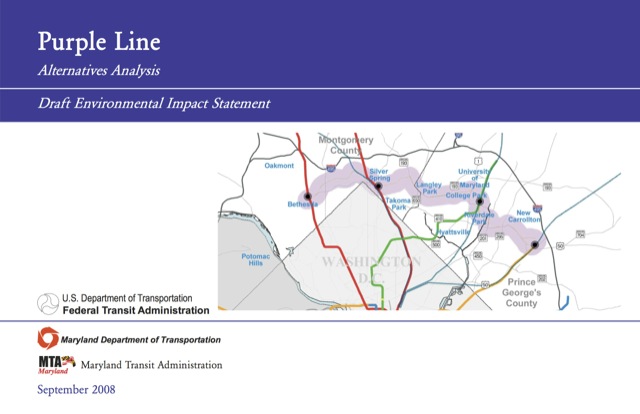Maryland state officials failed to indicate the slightest degree of embarrassment when they announced on Friday that the Maryland Purple light-rail line will be delayed again until Spring 2027 and cost an additional $148 million. When originally approved, the line was expected to cost just over $1.9 billion and to open in mid-2020. Even at that price it made no sense; although nobody but the Antiplanner read the full EIS, that document admitted that the line would significantly increase traffic congestion in Washington DC suburbs.
The executive summary of the Purple Line draft environmental impact statement implied that the purpose of the line was to reduce congestion, but a technical appendix calculated that it would make congestion far worse. However, hardly anyone but the Antiplanner bothered to read that appendix. Click image to go to a list of environmental documents and technical reports written for this boondoggle.
Now the line is $3.8 billion over budget, meaning it is costing about three times as much to build as originally projected. That number comes with a qualifier, however. Maryland is building the line through a public-private partnership in which it is contracting to the private partner to not only build it but to operate it for 30 years. The cost of the contract was originally supposed to be $5.6 billion and now is up to $9.4 billion but state officials refuse to say what portion of that is construction and what portion is operating costs. While it is possible that the operating costs grew which means the construction cost less than tripled, the $148 million increase includes a $205 million increase in construction costs and a $57 million reduction in operating costs.
“Public-private partnerships can be done well,” said one official. “We just haven’t done it well.” The reality is that the only public-private partnerships that are done well are ones in which the private partners accept the risks of cost overruns and demand shortfalls; most highway PPP projects are done that way. This contract was designed so that the public had to accept all of the risks; the only benefit of the PPP was that it helped government officials disguise the real costs of construction.
The Maryland official added that “there’s no turning back now” given all of the money that has already been sunk into the project. Actually, there is: they could turn it into a bus rapid transit line, which would reduce both construction and operating costs and could be easily adapted into highway or bicycle lanes if transit ridership is poor. The problem is that transit officials and politicians lack the imagination to do that.
This is a project that should never have been considered, and once evaluated should never have been built. Now that costs have risen so much, it has taught absolutely nothing to Maryland officials, who are hell bent on building a similar project in Baltimore.









Let’s be succinct. Even if cost controls and competive contracts. Rail cannot function as new tech.
What makes US unique compared to Europe and Asia is greater Tort and property rights.
Hence (Unless highway built) objection to rail systems usually as blight or noise.
Bigger is Light rail has nothing to do with transportation it’s about politically well connected engineering firms peddling obsolete technology.